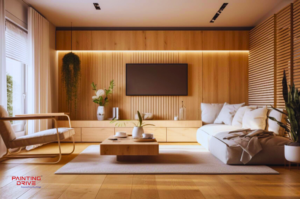Achieving a smooth finish with acrylic paint on wood furniture can transform a piece from mundane to stunning. This guide will walk you through the entire process, ensuring you end up with a professional-looking finish. Whether you’re a DIY enthusiast or someone looking to update your interior, these steps will help you achieve flawless results.

Step-by-Step Guide to Achieving a Smooth Finish
1. Gather Your Supplies
Before you start, ensure you have all the necessary supplies:
- Acrylic paint: High-quality acrylic paint suitable for wood.
- Primer: A good primer is crucial for a smooth finish.
- Sandpaper: Various grits (80, 120, 220) for different stages.
- Tack cloth: To remove dust between sanding.
- Brushes/Rollers: High-quality synthetic brushes or foam rollers.
- Putty knife: For applying wood filler.
- Wood filler: To fill in any imperfections.
- Drop cloth: To protect your workspace.
- Painter’s tape: To protect areas you don’t want to paint.
- Sealant/Topcoat: For added durability and a smooth finish.
2. Prepare Your Workspace
Set up a well-ventilated workspace. Lay down a drop cloth to protect your floor and nearby objects. Ensure you have adequate lighting to spot any imperfections during the process.
3. Prepare the Wood Surface
Cleaning
Start by cleaning the wood furniture to remove any dirt, grease, or old finishes. Use a mild detergent solution and a damp cloth. Allow the furniture to dry completely.
Sanding
Begin with coarse-grit sandpaper (80-grit) to remove the old finish and smooth out any rough areas. Sand along the grain of the wood to avoid scratches. Progress to a medium-grit (120-grit) and finish with a fine-grit (220-grit) to achieve a smooth surface.
Filling Imperfections
Inspect the wood for any dents, holes, or scratches. Use a wood filler and a putty knife to fill these imperfections. Allow the filler to dry according to the manufacturer’s instructions, then sand the filled areas smooth with fine-grit sandpaper.
Dust Removal
Use a tack cloth to wipe down the entire surface. This removes any dust and debris that could interfere with a smooth finish.

4. Apply Primer
Applying a primer is crucial for a smooth and durable finish. It helps the paint adhere better and provides a uniform base color.
- Choosing the Right Primer: Use a primer suitable for acrylic paint and wood surfaces.
- Application: Apply the primer in thin, even coats using a high-quality synthetic brush or foam roller. Allow the primer to dry completely, and lightly sand with fine-grit sandpaper (220-grit) to remove any brush marks or unevenness. Wipe away the dust with a tack cloth.
5. Paint Application
First Coat
Stir the acrylic paint thoroughly before use. Apply the first coat using a high-quality synthetic brush or foam roller.
- Technique: Use long, even strokes, and avoid overloading the brush or roller with paint. This helps prevent drips and brush marks.
- Drying Time: Allow the first coat to dry completely, as per the manufacturer’s instructions.
Sanding Between Coats
Lightly sand the dried paint with fine-grit sandpaper (220-grit) to remove any imperfections. Wipe away the dust with a tack cloth.
Additional Coats
Apply additional coats of acrylic paint, repeating the process of painting, drying, and sanding between each coat. Typically, two to three coats are sufficient for a smooth and even finish.
6. Apply a Sealant or Topcoat
To protect your painted furniture and enhance its durability, apply a sealant or topcoat.
- Choosing the Right Topcoat: Opt for a water-based polyurethane or a clear acrylic sealer.
- Application: Apply the topcoat in thin, even layers using a clean brush or foam roller. Allow each coat to dry thoroughly, and lightly sand between coats with fine-grit sandpaper. Apply at least two coats for optimal protection.
7. Final Touches
Once the topcoat is completely dry, inspect the furniture for any missed spots or uneven areas. Touch up as necessary with a fine brush.
8. Curing Time
Allow the painted furniture to cure fully before using it. Curing times vary, but generally, it takes about 1-2 weeks for the paint and topcoat to harden completely.
Learn more: Most Popular Ceiling Texture For Your Home?
Tips for Success
- Use Quality Materials: Invest in high-quality paints, primers, and brushes for the best results.
- Patience is Key: Allow adequate drying and curing times between each step to ensure a durable and smooth finish.
- Proper Ventilation: Ensure your workspace is well-ventilated to avoid inhaling fumes and to speed up drying times.
- Test First: Test your paint and primer on a small, inconspicuous area of the furniture to ensure compatibility and desired results.
By following these detailed steps, you can achieve a smooth, professional-looking finish on your wood furniture using acrylic paint. Whether you’re updating a family heirloom or adding a personal touch to a new piece, the effort you put into preparing and painting will be evident in the beautiful, lasting results.




